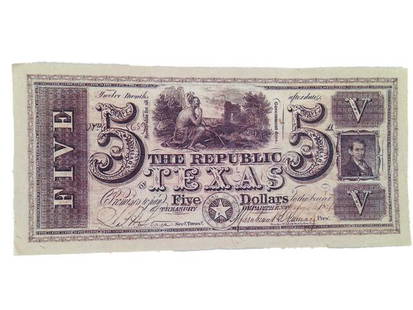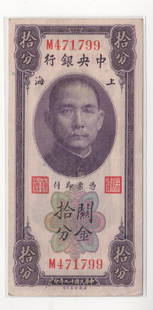
Republic of Texas Currency & Bank Notes
Similar Sale History
Recommended Items









Item Details
Description
Obsolete Republic of Texas Currency & Bank Notes
519. [TEXAS CURRENCY & BANK NOTES]. Collection of thirteen engraved pictorial specimens, of which nine are separate notes and four are on an uncut sheet, plus a few duplicates. Various places, ca. 1835-1840. Each note approximately 8 x 18.5 cm. Most with secretarial signatures and cancelled by cutting or ink cancellation. Overall, very good, in excellent impressions. Included in the lot is the pamphlet, William E. Howard, The Romance of Texas Money (Dallas, 1946). 8vo, wraps (fine).
These examples of Texas currency are significant for numerous reasons, not the least of which is the iconography and identity they present for the Republic. In addition to numerous stock presentations of strength and stability, such as Columbia and Justice, other images emphasis different areas of Texas strengths. Especially prominent are sea-faring images, including depictions of not only sail but also steam ships and busy wharves. The depictions of Native Americans are, however, mixed. Most images are peaceful and imply cooperation, although the image of the $20 note is aggressive, albeit contraposed with a peaceful image. Finally, the repeated images of trains are instructive. At the time, there were utterly no trains in Texas and very few in the U.S. at all, although the Texas Rail Road Navigation & Banking Company had been chartered on December 13, 1836. See Handbook of Texas Online (Money of the Republic of Texas); Herbert T. Hoover, “Ashbel Smith on Currency and Finance in the Republic of Texas,” Southwestern Historical Quarterly 71 (January 1968); E.T. Miller, “The Money of the Republic of Texas,” Southwestern Historical Quarterly 52 (January 1949).
§§§§§§§§§§
The collection consists of the following:
Commercial & Agricultural Bank of Texas
Uncut sheet of four pictorial $1.00 notes: The Commercial & Agricultural Bank of Texas Promises to pay the bearer One Dollar on demand Un Peso Columbia…. [lower center] Draper, Toppan, Longacre & Co., Phila. & New York. Columbia, Texas, ca. 1835. Unused. Topmost note with small nick at upper center affecting a few letters. Overall fine. Medlar, p. 49 (#18).
The iconography announces the transition of Texas from a Mexican state to an Anglo empire. The Mexican eagle is retained at the top, but the figure at the left looks like a forlorn Daniel Boone longing for home and his mama’s shoo-fly pie, while on the right side a Native American in a canoe glides by peacefully in a stream. Handbook of Texas Online (Banks & Banking): “In 1835 the legislature of Coahuila and Texas chartered the Banco de Comercia y Agricultura. This, the first commercial bank in Texas, provided a variety of banking services. The principals of the bank, which was based in Galveston, were merchants Samuel May Williams and Thomas F. McKinney. This bank helped arrange loans for the Texas Revolution and for funding the republic.” Streeter (60) notes that this bank was the first which actually did business in Texas. Williams and McKinney contemplated another such bank at Columbia, but it never opened, although this paper money had been printed. In 1840, by act of the Republic of Texas the partners were deprived of issuing further paper money.
Williams’ fiscal fantasy finally materialized around 1848 when his Commercial and Agricultural Bank of Texas in Galveston opened, two blocks off the Strand, “the Wall Street of Texas.” This sheet apparently dates from the early days of the bank, when it was still operating under Mexico’s authority. Most examples of these notes are known because they were used in the Confederate era to print Louisiana notes on their blank versos (Medlar).
Kelsey H. Douglass Privately Issued Notes
$1 note: Kelsey H. Douglass I Promise to pay on demand at…New Orleans…One Dollar…. [lower left] Rawdon, Wright & Hatch New-York [lower right] Rawdon, Wright, Hatch & Edson, New-Orleans. Nacogdoches, ca. 1840. Dated in manuscript January 1, 1840, and signed K.H. Douglass. Ink cancelled, but otherwise fine. Handsome issue with elaborate numeral "1" in circle and vine surrounds at left center, bison at lower center, Columbia en dishabille at top center holding olive branch and eagle, cotton bolls at right center, and Texas Lone Star at upper right. Medlar, p. 135 (#1).
$2 note: Kelsey H. Douglass I Promise to pay on demand at…New Orleans…Two Dollars…. [lower left] Rawdon, Wright & Hatch New-York [lower right] Rawdon, Wright, Hatch & Edson, New-Orleans [below central tableau] Engraved by Geo. W. Hatch. Nacogdoches, ca. 1840. Dated in manuscript September 10, 1839, and signed K.H. Douglass. Ink cancelled, but otherwise fine. Busy note with cotton plant at left, Commerce and Industry in dishabille at center framed by sail and steam ships, primitive steam engine towing two rail cars at lower center, Native American at upper right, and Texas Lone Star at center right. Medlar, p. 135 (#2).
Kelsey Harris Douglass (d. 1840) arrived in Texas before the Revolution and is known to have supplied the Army. He was instrumental in pushing Native Americans away from Anglo settlements and was a prominent Nacogdoches merchant. Unfortunately, he was somewhat too successful with his banknotes. His widow went bankrupt winding up his affairs.
Republic of Texas Currency
$1 note: The Treasurer of…The Republic of Texas Will pay One Dollar… [upper right] Endicott & Clark, New Orleans. Austin, ca. 1840. Dated in manuscript February 1, 1841, and signed James H. Starr and J.W. Simmons. Cut cancelled, but otherwise fine. At left a Native American with a bow in his left hand raises his right hand in greeting, and at top center Ceres rests amid signs of agricultural prosperity, such as wheat sheaves and livestock. Criswell Texas A1 (fourth issue).
$5 note: …The Republic of Texas Promises to pay Five Dollars… [lower left] Rawdon, Wright, Hatch & Edson, New Orleans [lower right] Rawdon, Wright & Hatch, New-York. Austin, ca. 1839. Dated in manuscript, October 29, 1839, and signed James H. Starr and Mirabeau B. Lamar. Cut cancelled and with printing defect caused by wrinkling in the press, but otherwise very good. At top center a Native American contemplates a scene of ruined buildings; at left center is Lamar’s portrait. Verso endorsed in ink “Certificate to be issued in the name of Warneken & Kirchoff.” A red back with prominent Lone Star and decorations printed in red on verso. Criswell Texas A4 (fifth issue).
$10 note: …The Republic of Texas Promises to pay Ten Dollars… [lower left] Rawdon, Wright, Hatch & Edson, New Orleans [lower right] Rawdon, Wright & Hatch, New-York. Austin, ca. 1839. Dated in manuscript, January 1, 1840, and signed James H. Starr and Mirabeau B. Lamar. Cut cancelled, but otherwise fine. At left Jupiter holds a lightning bolt aloft in his right hand; at right a ship is under full sail; at top center Venus arises from the ocean with the oyster shell mysteriously positioned atop her head. “Drawn and engraved by Geo. W. Hatch” (below Jupiter figure). A red back with prominent Lone Star and decorations printed in red on verso. Criswell Texas A5 (fifth issue).
$20 note: …The Republic of Texas Promises to pay Twenty Dollars… [lower left] Rawdon, Wright, Hatch & Edson, New Orleans [lower right] Rawdon, Wright & Hatch, New-York. Austin, ca. 1840. Dated in manuscript, February 1, 1840, and signed James H. Starr and Mirabeau B. Lamar. Cut cancelled, but otherwise fine. At left, a Native American draws and aims his bow; at upper center, Columbia and a Native American rest by a shield with the Lone Star emblazoned upon it; at left, a martial Columbia treads on a prostrate figure, its crown and chains in dust in the foreground. A train runs in the distant background. A red back with prominent Lone Star and decorations printed in red on verso. Criswell Texas A6 (fifth issue).
$50 note: …The Republic of Texas Promises to pay Fifty Dollars… [upper right] Draper, Toppan, Longacre & Co., Phila & NY. Houston, ca. 1839. Dated in manuscript, January 24, 1839(?) and signed Richard G. Dunlap and Mirabeau B. Lamar. Cut cancelled, but otherwise fine. At left a sailor drapes himself in a modified U.S. flag with Lone Star and raises his hat in his left hand; at center, Justice sits amidst a wharf scene with a stevedore in the middle ground and a sailing ship in the background. A red back with prominent Lone Star and decorations printed in red on verso. Kelsey, Engraved Prints of Texas, 1554-1900 D25.2 (p. 33).
$50 note: … The Republic of Texas Promises to pay Fifty Dollars…. [lower left] Rawdon, Wright, Hatch & Edson, New Orleans [lower right] Rawdon, Wright & Hatch, New-York. Austin, ca. 1840. Dated in manuscript, February 1, 1840, and signed James H. Starr and Mirabeau B. Lamar. Cut cancelled, but otherwise fine. At left, Venus rises from the ocean surrounded by sea monsters; at upper right sail and steam ships plough the waters; at center right is Lamar’s portrait. Criswell Texas A7 (fifth issue). Kelsey, Engraved Prints of Texas, 1554-1900 D25.1 (pp. 32-33).
$500 note: …The Republic of Texas Promises to pay Five Hundred Dollars… [lower left] Rawdon, Wright, Hatch & Edson, New Orleans [lower right] Rawdon, Wright & Hatch, New-York [below central tableau] Engraved by Geo. W. Hatch. Austin, ca. 1839. Dated in manuscript, May 3, 1839, and signed James Webb and Mirabeau B. Lamar. Cut cancelled, but otherwise fine. Upper left with Commerce and Industry in dishabille at center framed by sail and steam ships; at center right Columbia and eagle reclining next to shield. A red back with prominent Lone Star and decorations printed in red on verso. Criswell Texas A9 (fifth issue). This is a rare note in any condition.
These red backs had a mixed history. Although Texas currency began its run on fairly good terms, these later notes were generally so debased as to be nearly worthless. They were reissued several times after their original utterance in early 1839, falling in value each time. By February, 1842, the red backs had lost almost all their value. Upon annexation, the state of Texas was obliged to assume its own debt. As Howard remarks (p. 9):
Money issued during the Lamar administration and bearing no interest was legal tender and known as the Red Back money. The first issue of this currency witnessed its rapid decline and depreciation in value, despite the efforts of the Secretary of the Treasury, the able James H. Starr, a valiant and noble Texas patriot who did all that was possible to maintain its value, but his task was an impossible one. The rapid depreciation of this ill-fated currency continued until it became practically worthless and not acceptable for taxes or duties.
Buyer's Premium
- 20%
Republic of Texas Currency & Bank Notes
Shipping & Pickup Options
Item located in Austin, TX, usPayment



















































